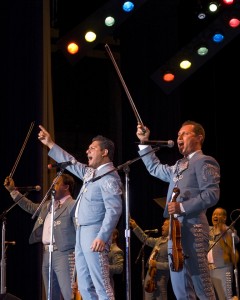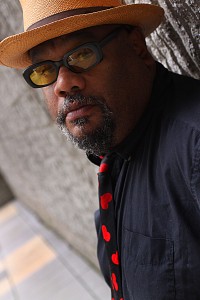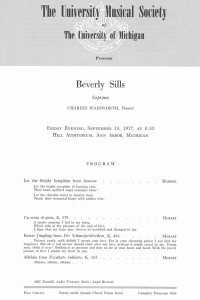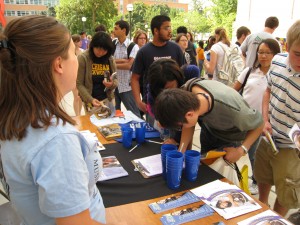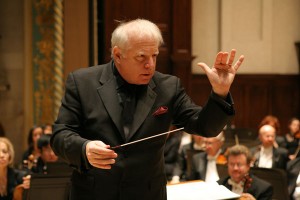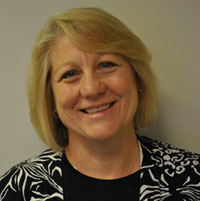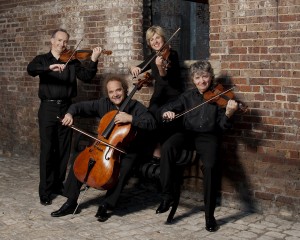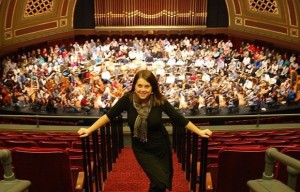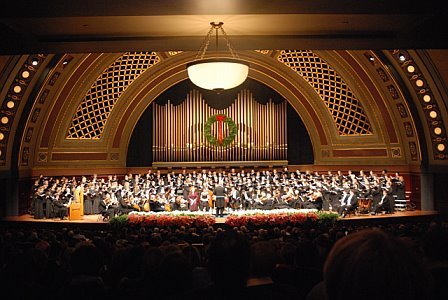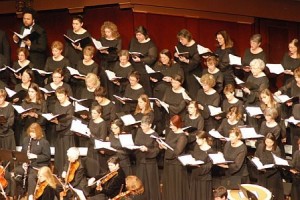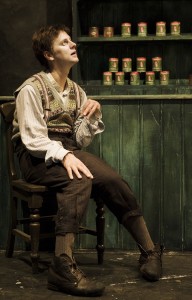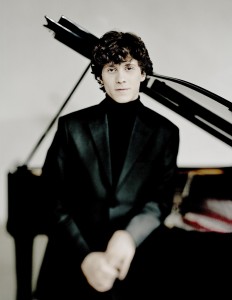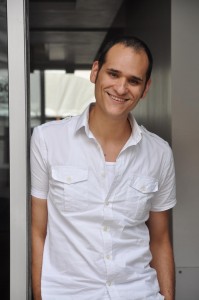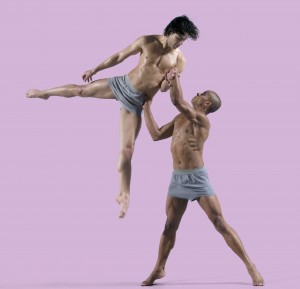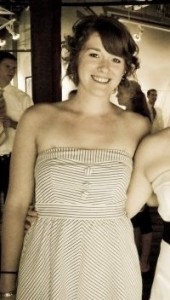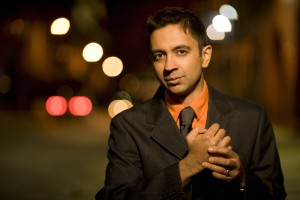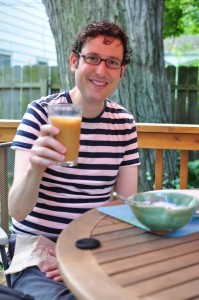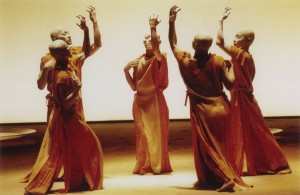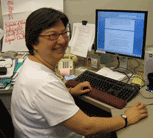Our Favorite Moments from the Season
It’s hard to believe the first half of the 10/11 season has already come to a close. What an incredible first half it was though for all of us on the UMS Staff! We thought it would be fun to share some of our favorite moments from these past few months, and we invite you to leave a comment sharing your favorite moment too!
“Attending the Mariachi Vargas de Tecalitlán concert solo, I sat next to a wonderful Spanish-speaking grandmother who took me under her wing and translated each and every song: ‘this is a song about love.’ Two songs later: ‘this too, is a song about love.’ I loved the audience for that show as much as I loved the incredible music!” ~Truly Render, Press & Marketing Coordinator
“My husband and I were mesmerized by Robert McDuffie at the Venice Baroque Orchestra performance featuring the “American Four Seasons” work by Philip Glass. The electricity and energy from the stage, as well as the audience, made us feel we had experienced a once in a lifetime event. The icing on the cake was watching Philip Glass walk onto the stage to congratulate Robert McDuffie and join the group for the applause and well-deserved bows.” ~Kathy Brown, Executive Assistant
“Seeing the space at 523 S. Main Street transformed into a club-style performance venue for Stew & The Negro Problem.” ~Mark Jacobson, Programming Manager
“I am a great lover of Mahler’s music, so my favorite moment had to be hearing the Mariinsky Orchestra perform Mahler 5. It was the first time I had heard the piece performed live, and it was an extremely moving experience to say the least! I was so impressed by the musicality of Maestro Gergiev and the emotion he drew out of the Orchestra.” ~Stephanie Normann, Marketing Manager
“That’s a hard call for me. One moment that will not soon be forgotten occurred while I was working the box office at the Once Festival: the line of patrons waiting to purchase tickets intermixed with School of Music students holding mirrors (they were doing a performance art piece). Also, as a patron, I can’t decide between the whole Susurrus experience and that AMAZING kazoo playing by the Carolina Chocolate Drops. “ ~Suzie Davidson, Assistant Ticket Services Manager
“There was this wonderful moment during the Mariachi Vargas de Tecalitlán concert when one of the mariachis handed the microphone to an older man in the front row. The man began singing along into the microphone – he knew ALL of the words and he sounded fantastic! He was doing so well that the mariachis let him sing almost the entire song. It was thrilling to see such an amazing interaction between the artists onstage and an audience member – and to remind us that these musical traditions grow out of us and our everyday lives, and that, as audience members, we are crucial participants in the art we experience. That was such a joyful moment not only for that man, but for all of us gathered in Hill that night.” ~Jim Leija, Manager of New Media & Online Initiatives
“Stew and the Negro Problem at 523 S. Main was a real highlight of the fall for me. It was so exciting to see us enter a new space and transform it into a perfect setting for the concert experience. Those concerts felt so fresh!”
~Liz Stover, Programming Coordinator
“My favorite moments during this season so far were spent on the trails of the Matthaei Botanical Gardens installing the wayfinding signage for Susurrus. I’d never been there before, and it’s really a gorgeous place, especially in the fall. Lots of free oxygen! My most panic-stricken moment (these tend to become fond memories a little later down the line)? Getting Maestro Gergiev back to the airport in time to catch a flight following his appearance with the Mariinsky Orchestra. It was a nail biter!” ~Mary Roeder, Residency Coordinator
“Watching the Venice Baroque musicians serenade our interns backstage during intermission of the concert. They were all so gracious and made our interns experience that evening unique and special.”
~Anne Grove, Artist Services Manager
“The moment I still think about is Susurrus: it was so different from any other sort of theatrical experience I’ve had. I remember the story, but even more, I remember the feeling of the morning as a whole: the beautiful setting, the weather that day, the people who were walking around with me or were just touring the gardens, Dame Janet Baker singing ‘Dido’s Lament’… When I think back on Susurrus, I remember those feelings of calmness and contemplation, and it makes me want to feel that way again.” ~Lisa Murray, Manager of Foundation & Government Grants
This Day in UMS History: Beverly Sills (September 23, 1977)
This Day in UMS History – September 23, 1977
Hill Auditorium
Beverly Sills, soprano
Charles Wadsworth, piano
Let the Bright Seraphim from Samson–Handel
Un moto di gioia, K. 579–Mozart
Bester Jüngling from Der Schauspieldirektor, K. 486–Mozart
Alleluia from Exsultate Jubilate, K. 165–Mozart
Many artists presented by UMS over its 132-year history have a long and rich history of performances with the organization. Soprano Beverly Sills was certainly no exception. Throughout the 1970s, Beverly Sills made numerous appearances under UMS auspices, culminating with this, her final appearance in 1977, just a few short years before announcing her retirement in 1980.
The late 60s and early to mid 70s were considered the high points of Beverly Sills’ career, as evidenced by her appearance on the cover of Time magazine in 1971, where she was described as “America’s Queen of Opera.” Beverly Sills’ first UMS appearance on January 30, 1971 was also a solo recital with Charles Wadsworth accompanying her on piano. On that particular program, Sills sang three arias from Handel’s opera seria Giulio Cesare. It is interesting to note that in 1966, Sills’ performance as Cleopatra in the New York City Opera’s revival of Handel’s then virtually unknown Giulio Cesare, is what many argue made her an international opera star.
Her final UMS program featured an aria from Handel’s oratorio Samson, considered by many to be one of Handel’s finest dramatic works, as well as three pieces by Mozart: concert aria “Un moto di gioia”, “Bester Jüngling” from the comic singspiel Der Schauspieldirektor (one of the only four vocal numbers in that piece), and “Alleluia” from the final allegro section of Mozart’s religious solo motet Exsultate Jubilate.
Following her retirement from performing, Beverly Sills remained quite active with the New York City Opera, serving on their board until 1991. Following that, she also served as chairman of Lincoln Center until 2002, and then as chairman of the Metropolitan Opera. Beverly Sills lost her battle with lung cancer on July 2, 2007 at the age of 78.
I hope you will take a moment to enjoy the video below and hear for yourself (if you weren’t able to attend any of her UMS performances!) the beauty and purity of tone of Beverly Sills’ voice as she sings one of my all-time favorite Mozart arias “Ruhe sanft, mein holdes Leben” from Zaide.
Come Visit UMS at Festifall!
Students, are you interested in live jazz, theater, classical music, and dance? Do you like cheap tickets??
Come visit the UMS table at Festifall (on the Diag, in front of the library) to get information on all of our incredible student ticket programs, inlcuding $10 Rush Tickets and the Fall Half Price Sale!
As a student, you can experience the world’s best live music, dance, and theater right here on campus — all at discounted prices!
UMS Staff Picks: Detroit Symphony Orchestra/Mahler’s Symphony No. 8 selected by Joanne Navarre, Manager of Annual Giving
SN: Mahler’s Symphony No. 8 (Symphony of a Thousand) is rarely performed due to the tremendous complement of musicians required of this work – what can audience members expect to see and hear when they attend this performance?
JN: They can expect to see and hear, first of all, excellent musicians. The “thousands” on the stage will include the Detroit Symphony, UMS Choral Union, U-M Chamber Choir, U-M University Choir, U-M Orpheus Singers, MSU Children’s Choir and the incomparable Leonard Slatkin leading the charge. The sheer mass of humanity will be impressive to see, and their music will be absolutely unforgettable.
SN: Have you ever seen another of Mahler’s Symphonies performed live? What about the performance(s) was the most memorable for you?
JN: Last season, I was fortunate to be in the audience when the San Francisco Symphony and Michael Tilson Thomas presented Mahler’s Symphony No. 2 (Resurrection), with the choral portion of the fourth movement being performed by the UMS Choral Union. Gustav Mahler believed that, “The symphony must be like the world. It must embrace everything.” In the Resurrection Symphony, he did exactly that; he embraced everything.
SN: What are you most looking forward to about experiencing Mahler 8 live?
JN: I am looking forward to experiencing the power and genius of Mahler’s music in the hands of Leonard Slatkin. This piece is Mahler’s magnum opus; in his words, “the greatest thing I have done.” For Mahler enthusiasts, this is the pinnacle.
SN: What other events are on your “must see” list for the 10/11 season?
JN: After Mahler 8, there are three things on my “must see” list: Susurrus (September 9-October 3, Matthaei Botanical Gardens); The Cripple of Inishmaan (Druid and Atlantic Theater Company), and Richard III and The Comedy of Errors (Propeller). I love theater.
JN: I am a sports fan. I like football and baseball, but I enjoy hockey most of all.
JN: Renée Fleming’s Handel arias, the Hilliard Ensemble’s Morimur, and Les Arts Florissants’ Charpentier album.
UMS Staff Picks: Takács Quartet selected by Liz Stover, Programming Coordinator
SN: The Takács Quartet has been treating UMS audiences to exceptional performances of chamber works for many years, but in the 10/11 season, there will be not one, but three very special opportunities to hear this quartet as they perform their Schubert Project cycle of concerts. What will be unique and memorable about each of these performances?
LS: It’s not every year that you get to hear so much of a single composer’s work in the span of a season, so I am thrilled for the opportunity to focus some attention on Schubert. While there’s not nearly enough time to hear all of his chamber music, we’ll hear some of my favorites: D.810 (“Death and the Maiden”), the “Trout” Piano Quintet, and the Cello Quintet! We’ve heard the Takács Quartet perform many times here in Ann Arbor (12, to be exact), but I’m also excited to hear them collaborate with other notable musicians: pianist Jeffrey Kahane (who is also music director of the Los Angeles Chamber Orchestra and Colorado Symphony), bassist John Feeney (principal bass of the Orchestra of St. Luke’s in New York), and cellist Paul Katz (who performed here three times as cellist of the Cleveland Quartet).
SN: Have you seen a performance by the Takács Quartet before?
LS: Yes. I saw them the last two times they were here, in March 2010 and April 2009, and I think in January 2007, too. I loved their April 2009 performance with Marc-André Hamelin when they performed the Schumann Piano Quintet. The first time I ever played chamber music for fun was with a piano quintet (though we played Brahms) so I really enjoy hearing that repertoire. It makes me think back to how challenging it was for me and how much I learned as a musician from playing in a small group rather than an orchestra.
SN: What are you most looking forward to about this series of performances?
LS: To begin with, I just love Schubert…his compositions can be so heartbreakingly romantic. Did you hear David Finckel, Wu Han, and Philip Setzer play the piano trios in February? There wasn’t a dull moment in that concert—it was a highlight of the season for me. As I mentioned before, it’s really exciting to hear so much of one composer’s work in one season, and this series of concerts lines up with a personal goal to build my knowledge of classical repertoire. I also share a love for chamber music (and Schubert) with my boyfriend Zack, who is a violist, so I’m looking forward to experiencing the concerts together.
SN: What other events are on your “must see” list for the 10/11 season?
LS: Mahler’s Fifth Symphony is one of the very reasons I work at UMS (hearing it performed by the New York Philharmonic in February 2005 made me instantly apply to become a UMS intern as a student) so I can’t wait to hear it again by the Mariinsky Orchestra. I’m also really excited about our collaboration with the Detroit Symphony Orchestra and Michigan Opera Theater to present Mahler’s Eighth Symphony. It’s a once-(or very few) in-a-lifetime opportunity to hear it performed and I’m excited to be involved in the production of that event. I’ve also become a huge dance lover over the past few years, so I’m looking forward to seeing all of the companies on our season—all are new to me! I also won’t miss Stew and the Negro Problem, Carolina Chocolate Drops, and Druid’s production of The Cripple of Inishmaan.
SN: What do you enjoy doing outside of work?
LS: Knitting! Almost two years ago, I began knitting seriously, and I have fallen in love with it! It’s a wonderful stress reliever and I just love the feeling of producing something. I’m currently working on a cardigan. I’ve even taught a few friends and coworkers to knit and it’s so exciting to see them producing beautiful garments. Besides that, I enjoy watching baseball (my boyfriend has turned me into a Red Sox fan), traveling, and spending time with friends and family (including my two dogs, Rumor and Gypsy, who live with my parents in the DC area). I’m also hoping to take my violin out soon and start playing more regularly as it’s been in my closet for the last year—I’m sure these concerts will inspire me to do so!
SN: What have you been listening to on your iPod?
LS: Since we presented Punch Brothers at the Power Center last summer, I have not been able to stop listening to them! Their CDs Punch and Antifogmatic are in very frequent rotation as well as some of their earlier work under Chris Thile’s name. I have also recently taken up spinning at the Y, and Lady Gaga helps me get through a solid hour of exercise. Other favorites include Broken Bells, Dave Matthews Band, Ingrid Michaelson, and Wilco. When it comes to classical music, Mahler and Rachmaninoff are two of my favorite composers, so this season’s repertoire is especially exciting for me!
Volunteer Spotlight: UMS Choral Union
After moving to Ann Arbor three and a half years ago, one of my first orders of business was to go online to find a chorus that I could audition for. Being a classically-trained singer coming from Jacksonville, Florida and having sung with the Jacksonville Symphony Chorus throughout the three years I lived there, I knew choral music-making was a part of my life I wanted to continue in Ann Arbor. It seemed a logical first step to go to the Detroit Symphony Orchestra’s website where I would presumably find audition information about their symphony chorus. Instead, I discovered that they did not have their own chorus, but performed choral pieces with a group called the UMS Choral Union. I decided to find out a little more about this chorus and discovered some particularly impressive facts: the group has a 132-year history, they won a Grammy Award in 2006, and they have 180 members. I had certainly found my chorus! An audition, countless Monday night rehearsals, and several incredibly memorable concert experiences later, singing with the UMS Choral Union has been everything and more that I hoped it would be!
Throughout my time singing with the Choral Union, I have always been amazed by the incredible variety of backgrounds, ages, and even geographic locations of the people that make up this volunteer ensemble. I recall from this past winter, one of my fellow choristers arriving to the rehearsal following the gold medal hockey game of the Vancouver Winter Olympics wearing a Team Canada hockey jersey and moose antlers! Yes, we even have singers that come from Windsor, Ontario to be a part of this amazing group. The UMS Choral Union holds auditions for new singers twice a year – once in the spring and once in the fall, and everyone is welcome to audition.
Despite all the diverse interests of the singers in the Choral Union, there is one unifying quality that brings us all together, and makes us more than happy to donate our time: our love of singing and making music as an ensemble. And this is exactly what we do when we come together for our two and a half hour-long rehearsals every Monday night to prepare the, on average, four pieces of music we perform with either the DSO or A2SO throughout the year. These rehearsals are led by conductor Jerry Blackstone, who has been the director of the UMS Choral Union since 2004. In the upcoming 10/11 season, Jerry will be preparing us for performances of Handel’s Messiah (a Choral Union tradition!), Mahler’s Symphony No. 8, Beethoven’s Symphony No. 9, and Mahler’s Symphony No. 3.
I’ve had people ask me “why do you give so much of your time to the Choral Union when you don’t get paid?” Simple: singing under the baton of legendary conductor Sir Neville Marriner, looking out into a packed house from the stage of Hill Auditorium after an unforgettable performance of Mahler’s Symphony No. 2 with the San Francisco Symphony, and getting a lump in my throat as I sing the final measures of the Alleluia in “Worthy is the Lamb” from Handel’s Messiah, even though I’ve sung it dozens of times before. These are all memories I have from the past year of singing with the UMS Choral Union; memories that are quite special to me…why would I not be involved in this incredible ensemble? I can hardly wait for the musical experiences ahead this season!
UMS Staff Picks: The Cripple of Inishmaan selected by Sara Billmann, Director of Marketing & Communications
SN: The multi-award winning Druid and Atlantic Theater co-production of Martin McDonagh’s The Cripple of Inishmaan has been described as “a break-your-heart, cruelly funny evening” – what kind of theatrical journey can audience members expect to experience when they see this production?
SB: I don’t want to spoil the story, but suffice it to say that it will be quite an emotional ride.
I’ve seen two of Martin McDonagh’s plays when they were produced in New York in the mid-late 1990s, and they are simply brilliant pieces, in part because of the way they force you to re-examine your own morals. He sets up these outrageous scenes that are absolutely hilarious, then delivers the knock-out punch that makes you realize you’ve been laughing at something that is, in fact, incredibly tragic. The June issue of <i>Opera News</i> put it perfectly: “As anyone who’s ever sat through a Martin McDonagh play can attest, sometimes the only response we can muster when confronted with the searing emotional or physical pain of others is a laugh.”
I read this play poolside while visiting my in-laws in San Antonio and found myself laughing out loud on any number of occasions. Let’s face it, there are many plays where you chuckle inwardly, but something that produces a spontaneous outburst while reading to yourself is extraordinary in its own sense. And based on every production I’ve seen of McDonagh’s work, the live production will far exceed what’s on the page.
So that we could all familiarize ourselves with the play, about a dozen members of the UMS staff did a “read-through” this summer. I hope that some audience members will be interested in doing the same — we’d be interested in putting together play-reading groups for others and loaning the scripts. It’s a great way to familiarize yourself with the dialects and turns of language that really bring the piece alive. And, of course, a great way to meet new people too.
SN: What are you most looking forward to about this UMS debut performance?
SB: It’s pretty simple, really – I just can’t wait to see what they do with the production to bring it alive. I have friends who saw this production when it was on Broadway a few years ago and raved about it. Having grown up in a small town, I recognize some of the quirky characters and look forward to seeing how they are realized on stage.
SN: What other events are on your “must see” list for the 10/11 season?
SB: Just about everything! As a trained classical musician, I’m particularly interested in the big orchestras and piano recitals. I was turned on to Denis Matsuev about two years ago by someone who had heard his recording in Gramophone magazine. His playing is really quite extraordinary. I also adore Schubert and am looking forward to the three Tákacs concerts, as well as the Scharoun Ensemble performance of the Schubert Octet. I’m also looking forward to Grupo Corpo – what a great company! I could go on and on. The beauty of being the marketing director for UMS is that I start to research all of the artists we’re presenting long before we announce the season, and I always get turned on to things I never would have thought I’d enjoy…which ultimately means that the entire season becomes a “must see” for me.
SN: What do you enjoy doing outside of work?
SB: I have two kids – Elisabeth is 8 and going into 4th grade, and Harry is 6 and going into 1st grade – who keep me plenty busy. I was about to respond that I do laundry outside of work, until I saw the word “enjoy” in the question. Elisabeth loves to play baseball, so I think I’ve spent the better part of July attending her games and taking her to see the Tigers when time permits. I’m also hopelessly addicted to The New Yorker and steal moments here and there to try to stay caught up. Other hobbies include wine tasting and walking the dog – we acquired a boxer/pointer mix from the Humane Society three months ago, and I’ve become the family’s designated dog walker, which fills up a shocking amount of time each day.
SN: What have you been listening to on your iPod?
SB: Ha! The day I get to listen to my iPod will be a great day indeed. Lately my kids have been torturing me, making me listen to “Stayin’ Alive” and 1980s dance tunes (oh, to return to the days when my daughter would watch “The Barber of Seville” by choice…). But when I can wrestle it away from them, I mostly listen to Schubert lieder, Maria Joao Pires performing Schubert and Chopin, Denis Matsuev playing Rachmaninoff, and Mahler, though truth be told, the iPod doesn’t do Mahler justice. Murray Perahia‘s recital in 2000 of the Bach/Busoni Chorale Preludes and the Goldberg Variations will always rank among my top UMS performances, and I often bring back that memory with the recording “Songs Without Words” released around the same time. Angelika Kirchschlager and Fritz Wunderlich are among my favorite singers, though I will confess that I also enjoy Pink Martini in my less serious moments. And I recently loaded on a CD by a wonderful Iranian group called Ghazal.
UMS Staff Picks: pianist Rafal Blechacz selected by Susie Bozell Craig, Marketing and Corporate Partnerships Manager
SN: Although a relatively young artist, Rafal Blechacz has already established himself as a rising star in the international classical music community. How has he, at only 25 years of age, made his mark in that community and around the world?
SBC: Although he’d won several major piano competitions already, when one wins the Chopin Competition it comes with incredible opportunities. Winning the Gold Medal and all individual prizes in 2005 opened the door for him to perform at Tchaikovsky Hall in Moscow with the Mariinsky Orchestra and Valery Gergiev, at the Concertgebouw in Amsterdam, Wigmore Hall in London, and the Palais des Beaux Arts in Brussels among others. It also helped secure a five-year recording contract with Deutsche Grammophon which has so far resulted in three albums, including perhaps the best recording of Chopin’s Preludes I’ve ever come across.
SN: What “flavor” does he bring to his performance that distinguishes him as such an impressive talent?
SBC: What impresses me so much about Rafal is the incredibly musical maturity he possesses. In many ways, technical prowess is the easy part. But the ability to spin phrases with perfect balance and timing, to not take too many liberties while still drawing out poignancy, the achievement of an incredibly organic result…this takes true mastery. Artists can work for years and still not achieve this.
SN: What are you most looking forward to about his upcoming Ann Arbor performance?
SBC: Chopin is one of my favorite composers for the piano, and to hear a true artist perform his works, which are so romantic with their sense of longing, nostalgia, grief…I think it will be an incredibly emotional experience.
SN: What other events are on your “must see” list for the 10/11 season?
SBC: I’m looking forward to both of the Russian orchestras, the Mariinsky and St. Petersburg, with their blockbuster programs; also Susurrus as a totally unique and intimate experience; and the two Shakespeare plays with Propeller Theater Company, both of which are new to me.
SN: What do you enjoy doing outside of work?
SBC: I’m a pretty active tennis player, and I before I started working at UMS I made a living as a flutist and still enjoy practicing and teaching. My husband and I are also looking forward to the birth of our first child late this fall.
SN: What have you been listening to on your iPod?
SBC: Well, yesterday I listened to Rachmaninoff’s second and third piano concertos in preparation for the season. I’m headed over to Lake Michigan next weekend and that always brings out summertime favorites like Jack Johnson and a quirky folk band from northern Michigan called Third Coast. It’s got a pretty wide array of artists to suit the occasion and mood.
Which pianist featured on the 10/11 season are you most looking forward to hearing?
UMS Staff Picks: Laurie Anderson’s Delusion selected by Jim Leija, Public Relations Manager
SN: Laurie Anderson’s daring and thought-provoking use of technology in her pieces has earned her worldwide recognition – just what kind of an artist is she and how can audience members expect to see her multi-media approach come to life in Delusion?
JL: As a student and practitioner of performance art, I’ve studied and admired the legendary Laurie Anderson for a long time. Anderson is an artistic pioneer, blending visual imagery, text, and electronic music (even inventing several unique electronic instruments) to create theatrical events that twist our perception of reality. A lot of her text reminds me of that of the late monologist Spalding Gray (who was a collaborator of Anderson’s): slightly offbeat and neurotic, strangely funny, and astutely observant. When you’re watching Laurie Anderson perform, you almost feel like you’re in a dream – quirky, bizarre, trancelike, too real, or not real enough. Anderson has an incredible talent for taking bits and pieces of our hyper-commercial, hyper-politicized society and spinning them into moments of hyper-realistic cyber-techno poetry that challenge authority, bend reality, and demand that we see the world differently. Audiences can expect to be surprised and challenged by the way Anderson transforms herself through what she’s called “audio drag”: sometimes she’s the cool, calm, collected self-help guru, sometimes she’s the evil robot of our worst sci-fi futuristic nightmares, and other times she’s a domineering patriarch. Never one to mince words, Anderson has recently explored highly charged issues like homelessness, terrorism, the war in Iraq, the collapse of Wall Street, and the oil spill in the gulf. I am most excited by contemporary artists like Anderson who are willing to tackle tough issues in ways that might leave audiences feeling a little uncomfortable and a little uncertain about how they should respond. I like to feel challenged by performance and to be shaken out of everyday complacency. I expect that in Delusion we’ll experience many of the Laurie Anderson “ingredients” that I’ve mentioned, and we’ll be transported into Anderson’s unusual, but compelling universe.
SN: Have you seen a performance by Laurie Anderson before?
JL: I’ve actually never seen Laurie Anderson perform live! I’ve only experienced her work through video and audio recordings. I’m looking forward to finally seeing her perform in-the-flesh after admiring and studying her work for so long.
SN: What other events are on your “must see” list for the 10/11 season?
JL: When I was working on my MFA in Art & Design, I experimented with sound installation and the ways in which an artist can use sound to change how people experience a particular place. I’m looking forward to Susurrus to see how David Leddy uses sound and narrative to recreate the Matthaei Botanical Gardens in a new and exciting way. I just have a feeling that Susurrus is going to be really magical.
Carolina Chocolate Drops is an absolute must. I saw the group when they first played at The Ark three years ago, and I still think back to that concert as one of the best I’ve seen in recent years. The CCD is so masterful at blending amazing bluegrass musicianship with educational tidbits about Black string music. I learned a lot, and I slapped my knee to the beat a lot, and I plan to do the same when they take the stage at the Michigan Theater.
SN: What do you enjoy doing outside of work?
JL: For me, the summer is all about vegetable gardening, going to the Ann Arbor Farmer’s Market, and cooking up a storm. I grow everything from tomatoes to eggplant to kale and herbs in my backyard garden, and my partner and I get a farm share from Tantre Farm in Chelsea. We love to see just how “local” we can be, especially during the summer months when so much amazing, fresh food is available in Ann Arbor.
SN: What have you been listening to on your iPod?
JL: The performance artist in me is listening to a lot of Lady Gaga. The chef in me is catching up on Splendid Table podcasts. The hipster in me is jamming to OK Go (can you believe that video with the Rube Goldberg machine?!).
Have you seen a live performance by Laurie Anderson before? We’d love to hear about your favorite performance artist!
UMS Staff Picks: Grupo Corpo selected by Rachelle Lesko, Development Administrative Assistant
SN: Grupo Corpo’s work has been described as “searing sensuality elegantly under control” (Le Monde, Paris)—what specific style(s) of dance can audience members expect to see at this performance?
RL: From the numerous video clips I have seen, they are masters of blending many different styles of dance like ballet, modern dance, and Brazilian dance. Each of these dance styles is known for different focal elements such as grace, fluidity, dynamic energy, and sensuality, and the way that Grupo Corpo manages to merge and transition between these different stylistic elements is incredible. The piece Imã, which they are performing in Ann Arbor, showcases a tremendous sense of fluidity and strength between the dancers. Throughout the course of the piece they seamlessly transition from modern dance and Afro-Brazilian visual and musical influences to lyrical ballet and lively, hip-shaking samba moves. I can’t wait to see it in its entirety.
SN: Have you seen a performance by Grupo Corpo before?
RL: I have not seen Grupo Corpo perform in person before, but I have attended many other UMS dance performances. A few that I particularly enjoyed over the years were Rubberbandance Group, Hubbard Street Dance Chicago, and the Trinity Irish Dancers — each of which embodies, in different ways, the energy, athleticism, and passion that can be found in Grupo Corpo. I love attending dance performances because of the sheer emotion and physicality present on the stage in front of you, which I find thrilling. I never get bored! There is always something to capture my attention, whether it’s the amazing technique of an individual or the interactions and broader picture of the group as a whole. I find dance companies that make a point to interweave different dance styles, like Grupo Corpo, especially enjoyable to watch because they throw in a little bit of the familiar for everyone, but then take you by surprise and bring it to a completely new and creative level.
SN: What are you most looking forward to about this performance?
RL: I think I am most looking forward to experiencing the blend of their particular dance styles, especially the incorporation of Brazilian samba and Afro-Brazilian roots. Latin dance (and music) is incredibly dynamic, infectious, and just plain fun! I can’t wait to see how Grupo Corpo brings that flavor to life on the stage AND to the audience.
SN: What other events are on your “must see” list for the 10/11 season?
RL: Wow. That’s a hard question! First of all, I want to say that I’m really excited about this season in general because there are so many artists coming that I personally am not familiar with and/or have never seen perform before, so I’m really looking forward to a year of new experiences. However, I do have a few that are definitely on my radar, like Rosanne Cash, Carolina Chocolate Drops, Rafal Blechacz, Tetzlaff Quartet, Mariachi Vargas de Tecalitlán… I’ll stop there, but I could go on! I think this season’s global focus on the Americas is going to be very exciting and I’m looking forward to attending many of those concerts.
SN: What do you enjoy doing outside of work?
RL: In my free time I enjoy playing the trumpet, both casually and in a local concert band, and spending time with friends and family. I also enjoy running and have recently started to participate in longer distance road races, which I find much more fun and exciting than the training part!
SN: What have you been listening to on your iPod?
RL: Well, a lot of what I’ve been listening to lately has been my running music so it’s a lot of upbeat 80’s rock music: Def Leppard, AC/DC, Journey, R.E.M, Madonna, etc., as well as some Natalie Merchant, Tori Amos, and Norah Jones to relax.
What is the most memorable dance event you’ve ever been to?
UMS Staff Picks: Vijay Iyer Trio and Rudresh Mahanthappa’s Apex selected by Mark Jacobson, Programming Manager
SN: This concert features a double bill of two jazz combos: the Vijay Iyer Trio and Rudresh Mahanthappa’s Apex. What can audience members expect to hear from these two ensembles? In what ways are they similar and different to each other?
MJ: Great question, as I believe that one of the essential hallmarks that distinguishes the success of any double-bill concert concerns the relationship—musical or otherwise—between the two ensembles or artists being presented. Vijay and Rudresh have shared a significant and meaningful musical journey together over the last decade and have undoubtedly influenced each other’s body of work. They have proven to be two of the most prolific artists of the new millennium distilled from the tremendous New York City improvising community, each simultaneously leading and writing for multiple ensembles that explore their varying individual interests and intellectual pursuits, including fusing South Asian musical forms and harmony with Western jazz traditions, to genre-defying, multimedia and spoken-word projects that explore issues of ethnicity and cultural identity.
Vijay’s long-standing trio has truly developed an original “sound,” mixing angular rhythms and challenging harmonies within an historical study and deep respect of popular and improvised music. Vijay’s ensemble has recently tackled musical “covers” of composers as diverse as Leonard Bernstein, visionary Andrew Hill, and pop sensation M.I.A.! Somehow, Vijay, Stephan, and Marcus have a collective ability to make this otherwise complex music accessible and enjoyable, and have been hitting on all strides.
Rudresh and Bunky Green’s co-led Apex is a brand-new quintet that only recently had its NYC debut this spring. Because of this, I haven’t yet had the opportunity to hear this band live, so we will need to wait to hear how Rudresh and Bunky’s approach will differ from that of Vijay’s trio! Using Apex as a vehicle to finally call public attention and due respect to septuagenarian jazz pedagogue Bunky’s contributions to the art form, I’m anticipating on-stage fireworks between the two alto saxophonists fueled by young Damion Reid, one of today’s most exciting New York drummers.
There is certainly a lot more to come from Rudresh and from Vijay, as both artists are still under the age of 40!
SN: Have you heard either of these combos, or members of them, perform live before?
MJ: I met Vijay and spent time with him when he was a guest of the Doris Duke Charitable Foundation and the NEA’s Jazz Initiative Annual Meeting of JazzNet partners in the summer of 2005 at the North Sea Jazz Festival in The Hague. Vijay is a musician that is equally comfortable communicating his artistic initiatives via both his live performances as well as through non-musical, verbal communication. The artistic goals of the trio are well-conceived and each member is whole-heartedly committed to the ensemble’s overall sound and style. Marcus Gilmore, who has been Vijay’s “first-call” drummer for a number of years, is actually legendary drummer Roy Haynes’ grandson! Marcus is not only one of the most skilled technicians on the drum kit, but his energy, fire, and natural “feel” make him someone to definitely watch…and hear.
SN: What are you most looking forward to about this performance?
MJ: As this concert will be presented in collaboration with the 2011 University of Michigan Jazz Combo Festival, I’m excited that so many young high school music students will have the opportunity to be exposed to “top-shelf” live improvisation. Great artists simultaneously assume tremendous responsibility and have the pleasure of being deeply influential to developing musicians—especially within the context of the jazz tradition.
SN: What other events are on your “must see” list for the 10/11 season?
MJ: My short list includes our UMS centennial celebration of gypsy guitarist Django Reinhardt by the Hot Clubs of Detroit and San Francisco ; Tony Award-winning songwriter and lyricist Stew’s band The Negro Problem, co-led with his partner Heidi Rodewald; the final opportunity to see the iconoclastic work of the Merce Cunningham Dance Company in Ann Arbor; and Fela Anikulapo Kuti collaborator and pioneer Tony Allen’s Afrobeat Tour direct from the man who “put the beat in Afrobeat” in April.
SN: What do you enjoy doing outside of work?
MJ: My wife and I had fraternal twins this past October (a girl and a boy!), so much of my time away from UMS is gladly being spent with them! Having children has, of course, opened my mind in so many wondrous ways. I have also managed to build a modest record collection (so much music is still only available on out-of-print LPs); I get a disproportionate amount of pleasure from discovering and listening to hard-to-find records or, for that matter, any music that is new to me.
SN: What have you been listening to on your iPod?
MJ: On heavier rotation recently has been a spring release on Warp Records by L.A.-based electronic artist Flying Lotus (born Steven Ellison) who is actually the late Alice Coltrane’s nephew! (I’ll forever remember working with Alice in one of her final concerts in September 2006 at Hill Auditorium….) I’ve also been enjoying Toronto-based Broken Social Scene’s ambitious Forgiveness Rock Record released on their own Arts & Crafts label. In the realm of improvisational music, I’ve been wowed by New York City-based alto saxophonist and composer Steve Lehman’s exploration (and realization!) of a “spectral harmonic” approach to ensemble writing and solo improvisation featured on Travail, Transformation, and Flow (Pi Recordings) by the Steve Lehman Octet. Truly astonishing. I’ve also been enjoying vocalist José James’ album with pianist/collaborator Jef Neve. In the world of large-scale, orchestral composition, I’ve been attempting to re-create the live experience of attending a semi-staged concert of composer Osvaldo Golijov’s magnum opus, La Pasión según San Marcos (The Passion according to St. Mark), at Lincoln Center’s Mostly Mozart Festival a couple of summers ago via a new recording of the work released on Deutsche Grammophon.
We’d love to hear which jazz event you’re most looking forward to on the 10/11 season!
UMS Staff Picks: Sankai Juku selected by Lisa Murray, Manager of Foundation & Government Grants
Welcome to the first in a series of weekly summer blog posts called “UMS Staff Picks”. These posts will feature my interviews with UMS staff members in which they discuss the event they are most excited for on the 10/11 season. I hope you enjoy this “behind-the-scenes” look at each event and the UMS staff member that chose it!
SN: Sankai Juku will be performing a dance style known as butoh – what is butoh? What can audience members expect to see at this performance?
LM: First off, amateur alert: I’m a very enthusiastic dance viewer, but I’m not an expert in the least. I hope others who know a lot more about dance will chime in and correct or augment what I’m writing.
From what I know, butoh is a dance style that originated in Japan after World War II and was in part a response to the horrors of that war. It’s a form of modern dance where certain kinds of movement are given particular emphasis, including movement that might be considered grotesque or ugly. Sometimes the dancers move VERY slowly; sometimes they isolate their movement down to what looks like a single muscle of the body; some butoh dancers contort their faces into grimaces that are truly frightening. Like a lot of modern dance, there’s not a story being told per se. It’s up to the viewer to make of it what they will.
If I were inviting a friend to come see the performance with me, I would first make sure to choose someone who is up for a little adventure or intensity. My husband, for instance, has gamely sat through many different performances by my side, but I don’t know if I can persuade him to come see Sankai Juku with me. Plus if I do convince him, there’s the risk I might end up seeing a Van Halen reunion concert or something like that in exchange…we’ll see.
SN: Have you seen a performance by Sankai Juku before?
LM: I haven’t seen Sankai Juku yet, but I think I’ve seen every other butoh performance UMS has presented over the past several years, and I’ve enjoyed them all immensely. One favorite was Dairakudakan, an ensemble with a style of butoh that veers toward the grotesque and unsettling…I still think about that performance. I also loved Eiko and Koma, a couple with a more quiet, graceful sensibility and a strong affinity between their art and the natural world. They performed in the Huron River (literally), and their movements were so incredibly slow that my sense of time was completely distorted. It was amazing to watch. Even though I haven’t seen Sankai Juku before, I’ve heard great things about them, and I know their performance will be memorable.
SN: What are you most looking forward to about this performance?
LM: I love butoh performances. For me, the total effect is haunting and completely mesmerizing. For others, I realize, the slowness of the pace might be a little hard to sit through. Anyone who sees them, though, will be blown away by the technique of the dancers. It takes an enormous amount of control to make your body move that slowly. I also love artists, like Sankai Juku, who are thoughtful and have a certain vision and then take that vision to the nth degree in their art. Not only do they let their freak flag fly, they grab their flag and walk down the middle of the street with it for everyone to see. I appreciate the courage it must take to make their art and then invite the rest of us along to experience it.
SN: What other events are on your “must see” list for the 10/11 season?
SN: What do you enjoy doing outside of work?
LM: I actually have a second job outside of UMS, working as an unpaid chauffeur for a young child and all of her after-school activities. There’s not much time beyond that. I think my husband and I went to see a movie a few years back. That was fun.
SN: What have you been listening to on your iPod?
LM: My child employer has become a big fan of Frank Sinatra. I don’t know how or why it happened, but I’m enjoying the opportunity to get re-acquainted with the Great American Songbook.
10/11 Divine Voices Series Announced
The Divine Voices Series celebrates the choral music tradition with three concerts at St. Francis of Assisi Catholic Church and one in Hill Auditorium.
The Route of the New World:
From Spain to Mexico
Jordi Savall and La Capella Reial de Catalunya
with Hesperion XXI
Tembembe Ensamble Continuo
Thursday, September 30 | 8 pm
St. Francis of Assisi Catholic Church
“The term ‘early-music superstar’ is surely an oxymoron. But in the most understated of repertory, on the most subdued of instruments, and in the most self-effacing way, Jordi Savall comes close to being one.” (The New York Times) Jordi Savall is an exceptional figure in today’s music world. For more than 30 years, he has been devoted to the rediscovery and performance of neglected musical treasures as soloist and director of three ensembles, two of which join forces with Mexico’s Tembembe Ensamble Continuo for this concert. For the past 15 years, Ensamble Continuo has explored the relationship between Mexican Baroque music and traditional Latin American instruments. This concert will trace the movement of music from Spain to the New World, bringing together ensembles from Spain and Mexico, and fusing Hispanic baroque and guitar music with contemporary jarocho and huasteco traditions.
The Tallis Scholars
Peter Phillips director
Thursday, November 4 | 8 pm
St. Francis of Assisi Catholic Church
Widely considered “the rock stars of Renaissance vocal music” (The New York Times), The Tallis Scholars were founded in 1973 by Peter Phillips, who remains their director nearly 30 years later. Through recordings and concert performances, they have established themselves as the leading advocates of Renaissance sacred music throughout the world. Named after the composer Thomas Tallis, the ensemble is widely recognized for the purity and clarity of its sound, which serves the Renaissance repertoire, allowing every detail of the musical lines to be heard. For this return appearance, The Tallis Scholars juxtapose works of Renaissance England with the contemporary Estonian composer Arvo Pärt, whose minimalist style finds inspiration in Gregorian chant.
Sequentia
Benjamin Bagby director
Thursday, January 27 | 8 pm
St. Francis of Assisi Catholic Church
For more than 30 years, the Ensemble Sequentia has set the standard for the performance of medieval music (from the period before 1300). After 25 years based in Cologne, Germany, the group has re-established its home in Paris, with a new program of vocal music from Notre Dame de Paris providing the impetus for this program. For centuries, Parisians and visitors to Paris have been thrilled by the imposing Cathedral of Notre Dame, whose massive towers and elegant flying buttresses dominate the Ile de la Cité. While today the area around the cathedral contains many of the trappings of a popular tourist site, in the 12th century, the cathedral of Notre Dame was situated within its own “campus” that enclosed nearly one-third of the island and housed an autonomous mini-state with its own laws and enforcement, free from the secular power wielded by the French king. Within this city within a city was the high altar, where the best young male vocalists in Europe were heard on important feast days, where the most innovative musical minds gave expression to new ideas in thrilling sonic structures that echoed the dynamic new architecture taking shape around them. This program draws from medieval vocal music from Paris in the 13th century.
Bach Collegium Japan
Masaaki Suzuki conductor
Thursday, March 24 | 8 pm
Hill Auditorium
Founded in 1990 by Masaaki Suzuki with the aim of introducing Japanese audiences to period instrument performance of great works of the Baroque period, the Bach Collegium Japan comprises both orchestra and chorus. The group has developed a formidable reputation through its recordings of J.S. Bach’s church cantatas, and returns to Ann Arbor after its 2003 St. Matthew Passion in St. Francis of Assisi Catholic Church. Widely regarded as one of the supreme achievements in classical music, the Mass in b minor was composed over a period of 25 years and assembled in its present form in 1749, the year before Bach died.
Program
J.S. Bach: Mass in b minor
Divine Voices packages (all four concerts) are $132 for general admission tickets or $172 for reserved tickets.
We’d love to hear your thoughts on the 10/11 Divine Voices series. Have you been to a previous performance by any of these ensembles? Each of them has performed in Ann Arbor in the past.
Mahler and Me: Preparing Mahler’s Symphony No. 2 from a UMS Choral Union Perspective
As a member of the UMS Choral Union for the past three years, I have thoroughly enjoyed performing some of the great masterpieces of choral music: Handel’s Messiah, Verdi’s Requiem, and Beethoven’s Ninth Symphony, to name a few. It has only been in the past couple of years though, that I have felt especially drawn to Mahler and his symphonies– the depth of emotion in his music never ceases to affect me in a very profound way, and I have grown to truly love his work. Last year, I learned that the Choral Union would not only be performing Mahler’s Symphony No. 2 in c minor (“Resurrection”), but we would be performing it with the San Francisco Symphony and conductor Michael Tilson Thomas. To say I was excited by this news would have been an understatement! This would be my inaugural performance of one of Mahler’s symphonies and I couldn’t wait to get started! Fortunately, I didn’t have long to wait as the Choral Union, under the guidance of conductor and music director Jerry Blackstone, began rehearsing the piece in late September of this past year.
At our first rehearsal, I sat down before warm-ups began and opened the new choral score of Mahler No. 2 that I had just picked up. I was instantly struck by what I saw on the page: straight-forward rhythms, a fair amount of unison singing between voice parts, and an awful lot of German text (my favorite language to sing in, so I wasn’t complaining). It looked almost elementary in a way, but this is not the case at all, as I have come to discover in the past several months that I have lived with this piece. Also printed in the score are a multitude of dynamics and nearly thirty different markings Mahler included, giving very specific directions on what he wanted from the chorus at various points. For example (translated from German), “Without standing out in the least” and “Somewhat slowing down again” – it is clear all of these nuances were very important to Mahler, and the vision he had for this piece. They have been equally important and emphasized by our conductor, Jerry, throughout our rehearsals as well, with no subtlety being overlooked. We were fortunate enough to have one of our recent rehearsals led by Ragnar Bohlin, the conductor of the San Francisco Symphony Chorus. As Jerry mentions in my video conversation with him, included in this blog post, this was a great rehearsal in which Mr. Bohlin helped us perfect our intonation and unification as an ensemble.
The length of time the chorus sings in this piece is actually quite short; Mahler’s Symphony No. 2 is a five-movement symphony with the chorus coming in halfway through the final movement. The text is taken from a setting of Friedrich Gottlieb Klopstock’s Die Auferstehung (The Resurrection). It is quite powerful, and the music Mahler wrote for it very effectively paints the picture of the hope, renewal, and rebirth that the text describes. Jerry has paid careful attention to accurate and unified pronunciation of the German text throughout our preparation of this piece. As the text plays an integral part in conveying the emotion of the music, it has not been uncommon for him to stop us several times while rehearsing until every last vowel and syllable in a phrase is correct and sung beautifully. The orchestration when the chorus enters is minimal but builds to a full, lush sound which includes “the largest possible contingent of strings” (Mahler’s own words), seven different percussion players, the introduction of the organ, and the tolling of deep bells during the final moments of this piece.
Mahler wrote of the final movement of this symphony, “The increasing tension, working up to the final climax, is so tremendous that I don’t know myself, now that it is over, how I ever came to write it.” (Natalie Bauer-Lechner, Recollections of Gustav Mahler) I personally have been humbled by the genius of this piece, and am very eagerly anticipating the culmination of all of our rehearsals when the Choral Union shares the stage with the San Francisco Symphony and Michael Tilson Thomas on March 20 to perform this amazing work. I am quite certain this performance will be one of, if not the highlight of my singing career thus far!


